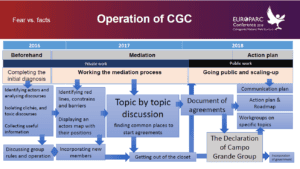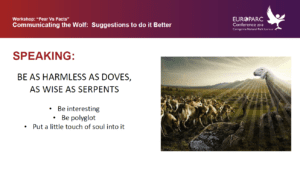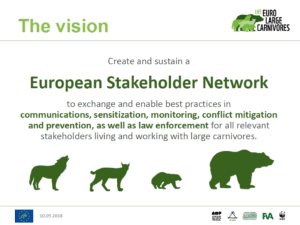Fear Versus Facts: effective communication for coexistence with large carnivores
Photo from Rodopi National Park, Greece
How can Protected Areas effectively communicate towards ensuring constructive dialogues and building acceptance of large carnivores amongst local communities? To reflect on this question and understand the challenges ahead, EUROPARC with the collaboration of the EU Platform for Coexistence between People and Large Carnivores, organised a workshop at the EUROPARC Conference 2018, which took place in the Cairngorms National Park (Scotland, UK) last month. Experts in large carnivores and protected area professionals gathered to find out solutions and share experience. This is what they’ve found out:
1) From conflict to collaborative work
One of the main challenges for conflict management is to overcome communication and language barriers between the different categories of stakeholders. Antagonism is frequently a result of the fact that each group simply wants to push forward its own agenda, without listening to others. There is, instead, a clear need to provide guidelines and expertise on how establishing a constructive dialogue and to improve the communication skills of professionals.
Problems related to coexistence with large carnivores are inevitably complex and for this requires complex answers: simplified messages are counterproductive. For this reason,
the first step is to ensure that parties acknowledge the existence of the problem, which has to be clearly identified and defined.

Click on the image to download the presentation of the Campo Grande Group at Workshop “Fear versus Facts” (EUROPARC Conference 2018, Scotland)
Case Study 1: Campo Grande Group (Spain)
Pedro Herrera, from Foundation Entretantos (Spain), presented the existing conflict with the Iberian wolf and explained how they have helped set up a working group which integrates farmers, ecologists, hunters, researchers, and wolf specialists, and through several participatory processes and meetings, they launched the Declaration of the Campo Grande Group.
2) Effective Mediation in 8 steps
Gathering stakeholders and give them the chance to speak and share their perspective is essential, but the role of the moderator is essential to keep the group focused on the existing problem. Often, large carnivores are labeled as the core problem, while they soon appear to be sort of “nuance” to raise or discuss other issues or secondary elements of bigger – and less tangible – problems (as for instance local or regional policy; access to funding; rural development…).
When conflicts originate, some tips to better manage have been discussed and identified by the workshop participants. Among those:
- Analyse and plan
It is crucial to develop in advance good communication processes and plans. What will be the key outputs of my working sessions? Who are the most relevant stakeholders? Which tools can we use to engage them? Those will contribute to make messages more consistent and effective. Communication is a complex tool and needs to have a clear purpose in order to contribute to solve the issue.
- Adapt to your audience
It is important to speak the “language” of the stakeholders we are dealing with: farmers, hunters.
- A neutral agent in the room
Trying to solve a complex issue requires negotiation ability and acceptance of compromises. For this, it is highly recommended to involve third parties, professional mediators and facilitators.
- Promote knowledge share
Provide learning exchanges and site visits to build mutual understanding and trust. You can also explore solutions from different regions and to discuss the concrete side of the problem by hearing and understanding how others are doing it.
- Open up to different perspectives
It is important to consider the ecosystems in their complexity and from different perspectives. All species are relevant, both the wolf and the sheep. Develop active listening with your stakeholders, understand their needs and stimulate a healthy share of ideas and perspectives.
- Don’t forget the people dimension
Put emphasis on people and show activities that can be undertaken to solve their problem – take emotions into account, without forgetting facts/data.
- Create a friendly environment
Stakeholders need to know each other: create opportunities to overcome the mental barriers. They need to find the pleasure in staying together: music, food, fire and drinks are very important ingredients.
- Identify key persons
It is very useful to identify persons within the different stakeholder’s groups who can help to mediate and pass positive messages among their colleagues. On the other hand, it is also crucial to identify those who generate a negative feeling among the community (for example, writing articles, disruptive news, inflaming people, creating sort of fake associations / representing groups of stakeholders and then express positions on behalf of the whole community…) and work directly with them.
Case study 2: Sense and Sensibility – Rethink the Rational Approach in Large Carnivores Communication

Click on the image to download the presentation of the project Life WolfAlps, at the workshop “Fear versus Facts” (EUROPARC Conference 2018, Scotland)
Irene Borgna, Communications Manager of the Life WolfAlps Project (coordinated by the Alpi Marittime Regional Park, Italy), shared the main challenges in communicating the natural return of the wolf in the Alps. What were the main obstacles? What are the lessons learned to overcome them?
3) How to empower Protected Area Managers
In terms of support required by Protected Areas managers, the following aspects were identified:
- Practical case studies, not just from protected areas, but mainly from the farmers perspective, to understand where things are working better. A common database to access resources would surely be useful. Meanwhile, the EU Platform of coexistence between people and Large Carnivores has already available a wide collection of case studies.
- More opportunities for learning exchange and study tours (mixt groups of stakeholders)
- Coordinated actions and information to make public and stakeholders aware that protected areas are well conscious of the problem and are working to solve it.
- More attention to be devoted to people and not only on the species in the development and management of projects, in the production of guidance.
- Training and support in mediation processes and facilitation.
- Have access to a unified database of information, a sort of communication toolkit that would collect relevant information from various projects.
Case study 3: The EuroLargeCarnivores LIFE project

Click on the image to download the presentation about the EuroLargeCarnivores Life project, at “Fear versus Facts” workshop (EUROPARC Conference 2018, Scotland)
László Patkó, Large Carnivore Programme Manager at WWF Hungary, introduced the EuroLargeCarnivores project that aims to provide a discussion space for people to share and learn about experiences of managing the presence of large carnivores. This includes various approaches across Europe associated with social, economic and ecological challenges. Topics include monitoring, conflict mitigation, damage prevention, security concerns, long-term effects on agriculture and hunting, management practices, as well as assisted economic opportunities.
